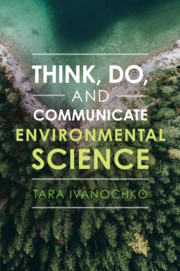Book contents
- Think, Do, and Communicate Environmental Science
- Think, Do, and Communicate Environmental Science
- Copyright page
- Contents
- Prologue
- Acknowledgements
- Introduction
- Part I Thinking Environmental Science
- Part II Doing Environmental Science
- Part III Communicating Environmental Science
- Chapter 13
- 13 Writing a Science Proposal
- Chapter 14
- Epilogue
- Appendix: Working in Excel
- Glossary
- Index
13 - Writing a Science Proposal
from Chapter 13
Published online by Cambridge University Press: 23 April 2021
- Think, Do, and Communicate Environmental Science
- Think, Do, and Communicate Environmental Science
- Copyright page
- Contents
- Prologue
- Acknowledgements
- Introduction
- Part I Thinking Environmental Science
- Part II Doing Environmental Science
- Part III Communicating Environmental Science
- Chapter 13
- 13 Writing a Science Proposal
- Chapter 14
- Epilogue
- Appendix: Working in Excel
- Glossary
- Index
Summary
Writing a proposal is the first step to getting a project approved and funded. In many cases, a call for proposals is like a competition where the most persuasive proposal will get approved and others will not. In science, persuasive writing is not hyperbolic or purposefully evasive. Taking a narrow view of a topic to elevate its importance is not an effective way to write a persuasive science proposal. A persuasive science proposal clearly and accurately articulates the motivating problem and outlines the methodology chosen to address the problem in a logical and systematic way. Scientists use references as supporting documents to authenticate statements. Effective referencing increases the quality of the proposal.
- Type
- Chapter
- Information
- Think, Do, and Communicate Environmental Science , pp. 200 - 213Publisher: Cambridge University PressPrint publication year: 2021

